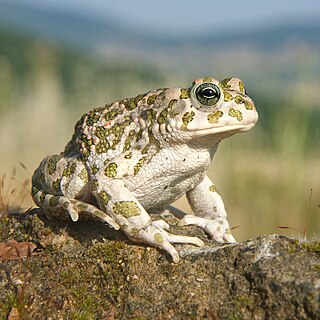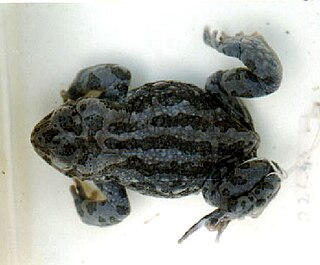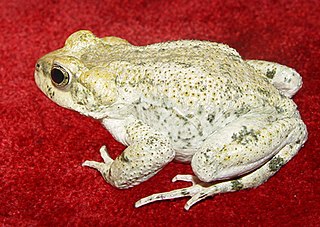 W
WBufotes, the Eurasian green toads or Palearctic green toads, is a genus of true toads. They are native to Europe, western and central Asia and northern Africa; a region roughly equalling the western and central Palearctic. Historically they were included in the genus Bufo and then for a few years placed in Pseudepidalea, which is a synonym of the currently accepted name Bufotes.
 W
WThe African green toad is a species of toad found in North Africa from Western Sahara to Egypt, and on the Italian islands of Sicily, Favignana, Lampedusa and Ustica. The populations on the Italian islands were described as a separate species, the Sicilian green toad, in 2008, but more recent authorities treat it as a subspecies of the African green toad because they are very closely related. Both were historically included in the European green toad and all have been included in the genus Bufo. It was previously suggested that the African green toad might range east into Sinai and the Levant, but a review has shown that this involves the related B. sitibundus. The African green toad is found from coastal areas to highland plateaus in forests, scrubland, grassland, semi-deserts and deserts; it breeds in temporary ponds and similar habitats.
 W
WThe Balearic green toad is a toad belonging to the true toad family, Bufonidae, from Italy and islands in the western Mediterranean Sea. It is mostly a lowland species, but can be found as high as 1,300 m (4,300 ft) asl in central Italy.
 W
WThe European green toad is a species of toad found in steppes, mountainous areas, semi-deserts, urban areas and other habitats in mainland Europe, ranging from far eastern France and Denmark to the Balkans and Western Russia. As historically defined, the species ranged east through the Middle East and Central Asia to western China, Mongolia and northwestern India, and south through Italy and the Mediterranean islands to North Africa. Following genetic and morphological reviews, 14 population are now regarded as separate species. These species and the European green toad are placed in their own genus Bufotes, but they were included in Bufo.
 W
WBufotes latastii, commonly known as the Baltistan toad, Ladakh toad or vertebral-banded toad, is a species of toad in the family Bufonidae. It is found in the West Himalayan region at altitudes of 780–3,200 m (2,560–10,500 ft) from northern Pakistan to Ladakh in India; although sometimes reported elsewhere, this is the result of misidentifications of other species. It is found in alpine forests, coniferous forests, grasslands, paddy fields, mountain desert and roadsides. It often lives near water, like lakes and ponds, in the riparian growth. It can be beneficial to humans as it feeds on insects and their larvae within areas of agriculture.
 W
WBufotes luristanicus, the Lorestan earless toad or Lorestan toad, is a species of toad in the family Bufonidae. It is endemic to the Zagros Mountains in Iran and occurs at an altitude of 350–1,300 m (1,150–4,270 ft), most often near rocky outcrops or freshwater ponds, which it also uses for breeding. Little is known about this species, but it is not considered threatened overall. Some local populations may be threatened by habitat loss from human activities or drought.
 W
WBufotes pewzowi is a species of toad in the family Bufonidae. It is found in dry plains of Central Asia, the foothills and mountains of Tian Shan, Zhungar Alatau and Pamir Mountains, the mountains and deserts of Western China and Mongolia, and probably westward to northern Afghanistan and north to Lake Balkhash in Kazakhstan and northeast Altai Republic in Russia. The specific name pewzowi honours Michail Wassiljewitsch Pewzow, a Russian geographer, cartographer, and explorer. Common names include Xinjiang toad and Pewzow's toad; when subspecies B. p. strauchi is recognized, it can be referred to as northern Xinjiang toad, while the nominotypic B. p. pewzowi then becomes southern Xinjiang toad.
 W
WBufotes surdus, also known as Iranian earless toad, Iranian toad, Pakistan toad, or Luristan toad, is a species of toad in the family Bufonidae. It is found in southern Iran and western Pakistan. There is also an isolated record from eastern Iraq.